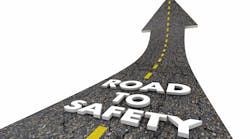One single fix can improve safety performances of a fleet. But making comprehensive adjustments can take a fleet from “high risk” to safe, according to a recent study by the National Surface Transportation Safety Center for Excellence (NSTSCE), that shows changes throughout a company can reduce crashes and strengthen safety.
Changing fleet culture to prioritize safety along with adding advanced technologies to commercial vehicles can have the biggest effect on turning a “high risk” fleet into a safe fleet, according to the study.
All the fleets studied became safer — as they experienced fewer major crashes and improved safety scores. Researchers interviewed the carriers about their safety improvement strategies to identify best practices that other high-risk fleets can implement.
The research team from the Virginia Tech Transportation Institute’s NSTSCE worked with insurance company Travelers, the National Safety Council, and state trucking associations to study nine carriers that experienced significant improvements in safety, including fleets that were once classified as “high risk” by the Federal Motor Carrier Safety Administration (FMCSA).
“The results of this study indicate that a comprehensive approach to reducing crashes — which includes deploying advanced technology and building a strong organizational safety culture — can reduce fatalities and injuries on our roadways,” said Alex Epstein, director of transportation safety for the National Safety Council. “We hope other carriers are able to learn from this research and take action to make their own fleets safer, the end result being safer roads for all and closer to our goal of zero fatalities.”
Each of the carriers studied was able to improve its record on the road by targeting safe drivers for new hires, along with increasing safety training for current and new drivers, according to the study’s conclusion. The fleets also developed proactive management programs to encourage safe driving and built stronger safety cultures such as improved driver scheduling to reduce fatigue, equipping trucks with technologies to assist the driver, and added vehicle maintenance to ensure each truck was in good working condition.
Major study findings
- Six out of nine carriers reported that building a strong safety culture increased safety outcomes. Management and driver buy-in to safety programs were reported to be an especially important factor. Several carriers also reported benefits from generating buy-in from other parts of the carrier’s organization, including the operations department and dispatch.
- Other best practices that helped build a strong safety culture included:
- Sharing carrier-wide safety indicators with managers and drivers.
- Implementing improvements in hiring policies and/or training procedures and modifying driver scheduling to reduce fatigue.
- Having zero-tolerance policies for hours-of-service violations in order to proactively address safety concerns.
- Informing drivers about the carrier’s safety culture during orientation, and having all employees, not just drivers, participate in safety training and education.
Carriers that developed a well-rounded safety culture experienced a substantial reduction in FMCSA-reportable crashes, according to the study. Among the highlights:
- Six out of nine carriers reported that adopting at least one advanced safety technology significantly improved safety outcomes. One carrier reported a 56% decrease in preventable, rear-end collisions after equipping its trucks with automatic emergency braking systems. Other technologies that improved safety include video-based onboard safety monitoring systems, lane-departure warnings, blind-spot detection and stability control systems.
- Of the 69 strategies reported, 59 were pre-crash countermeasures. Also, a large portion of the pre-crash countermeasures, or proactive actions taken by carriers, focused on the management culture and leadership buy-in on safety. This supports prior research that suggests a connection between a carrier’s organizational safety culture and actual safety performance. Carriers also reviewed crash data and information from the advanced technology systems to proactively address areas in need of improvement.
- There was no single fix for improved safety performance. None of the carriers that significantly improved safety implemented only one change. Instead, all the carriers made comprehensive adjustments. These included changing management practices; implementing new technologies: and improving driver and manager training, hiring guidelines, scheduling and vehicle maintenance procedures.
“Our findings were largely consistent in terms of the countermeasures the nine carriers viewed as influential factors in their improved safety records,” said Matthew Camden, the project’s principal investigator and senior research associate for VTTI’s Center for Truck and Bus Safety. “Overall, the carriers attributed their success not to one ‘single fix’ solution but rather the fact that they adopted a comprehensive approach to safety culture and practices within their companies, specifically the adoption of advanced safety technologies.”
There are common elements to fleet safety programs that can help all carriers protect their equipment, their cargo and their drivers, according to Chris Hayes, second vice president of transportation, risk control at Travelers. “This study highlighted safety measures that proved most effective for the participants and can be incorporated by others to achieve positive results,” he said.
The research team will present a detailed discussion of the results at the Fleet Safety Conference on Oct. 28–30 in Henderson, Nevada.




